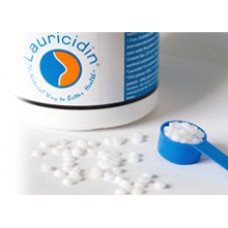*** 8 Oz (227 Grams) ***
*****Antiviral Effects*****
Hierholzer and Kabara (1982) first reported the antiviral activity of the monoglyceride of lauric acid (monolaurin) on viruses that affect humans.. They showed virucidal effects of monolaurin on enveloped RNA and DNA viruses. This work was done at the Center for Disease Control of the U.S. Public Health Service. This study was carried out using selected virus prototypes or recognized representative strains of enveloped human viruses. All these viruses have a lipid membrane. The presence of a lipid membrane on viruses makes them especially vulnerable to lauric acid and its derivative monolaurin. These initial findings from the Center of Disease Control (CDC) have been confirmed by many other investigators. Research has shown that enveloped viruses are inactivated by added fatty acids and monoglycerides in both human and bovine milk (Isaacs et al 199 1). Others (Isaacs et al 1986, 1990, 1991, 1992; Thormar et al 1987) have confirmed Kabara's original statements concerning the effectiveness of monolaurin. Some of the viruses inactivated by these lipids are the measles virus, herpes simplex virus (HSV-1 and -2), herpes family members (HIV, hepatitis C, vesicular, stomatitis virus (VSV), visna virus, and cytomegalovirus (CMV). Many of the pathogenic organisms reported to be inactivated by these antimicrobial lipids are those know to be responsible for opportunistic infections in HIV -positive individuals. For example, concurrent infection with cytomegalovirus is recognized as a serious complication for HIV positive individuals (Macallan et al 1993). Thus, it would appear imperative to investigate the practical aspects and the potential benefit of a nutritional supplement such as monolaurin (Lauricidin®) for microbial infected individuals. Until now few nutritionists in mainstream nutrition community seem to have recognized the added benefit of antimicrobial lipids in the support of infected patients. These antimicrobial fatty acids and their derivatives are essentially nontoxic to man. According to the published research, lauric acid is one of the best "inactivating" fatty acids, and its monoglyceride is even more effective than the fatty acid alone (Kabara 1978, Sands et al 1978, Fletcher et al 1985, Kabara 1985). It should be emphasized that lauric acid cannot be taken orally because it is severally irritating. Lauricidin® on the other hand, a derivative of lauric acid chemically bonded to glycerin to form monolaurin, can be taken orally without any problem.
*****Antibacterial Effects*****
The potentially pathogenic bacteria inactivated by monolaurin include Listeria monocytogenes, Staphylococcus aureus, Streptococcus agalactiae, Groups A, streptococci-gram-positive organisms, and some gram-negative organisms (Vibrio parahaemolyticus and Helicobacter pylori). Decreased growth of Staphylococcus aureus and decreased production of toxic shock syndrome toxin-l was shown with monolaurin (Holland et al 1994). Monolaurin was 5000 times more inhibitory against Listeria monocytogenes than ethanol (Oh & Marshall 1993). In vitro monolaurin rapidly inactivate Helicobacter pylori. Of greater significance there appears to be very little development of resistance of the organism to the bactericidal effects (Petschow et al 1996) of these natural antimicrobials. A number of fungi, yeast, and protozoa are also inactivated or killed by monolaurin. The fungi include several species of ringworm (Isaacs et al 1991). The yeast reported to be affected is Candida albicans (Isaacs et al 1991). The protozoan parasite Giardia lamblia is killed by monoglycerides from hydrolyzed human milk (Hemell et al 1986, Reiner et al 1986, Crouch et al 1991, Isaacs et al 1991). Chlamydia trachomatis is inactivated by monolaurin (Bergsson et al 1998). Hydrogels containing monocaprin/monolaurin are potent in vitro inactivators of sexually transmitted viruses such as HSV-2 and HIV-1 and bacteria such as Neisserian gonorrhea (Thormar 1999). Monolaurin does not appear to have an adverse effect on desirable gut bacteria, but rather on only potentially pathogenic microorganisms. For example, Isaacs et al (1991) reported no inactivation of the common Esherichiacoli or Salmonella enteritidis by monolaurin, but major inactivation of Hemophilus influenza, Staphylococcus epidermis and Group B gram positive streptococcus.
MonoLaurin (Labeled Lauricidin)
- Product Code: 304134
- Availability: 18
-
$34.99

